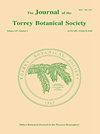Life form, habitat, and nutritional mode of the flowering plants of central French Guiana
IF 0.8
4区 生物学
Q4 PLANT SCIENCES
引用次数: 5
Abstract
MoRI, S. A., E. F HECKLAU, AND T. KIRCHGESSNER (The New York Botanical Garden, Bronx, New York 10458-5126). Life form, habitat, and nutritional mode of the flowering plants of central French Guiana. J. Torrey Bot. Soc. 129: 331-345. 2002.-The flowering plants of central French Guiana comprise 1918 native species, including 549 species of herbs, 44 species of vines, 45 species of subshrubs, 269 species of shrubs, 245 species of lianas, and 766 species of trees. The habitat of the flowering plants of central French Guiana is primarily terrestrial. A total of 1653 species or 86% of the flora occurs in this habitat. However, the reproductive cycles of a majority of the flowering plants of central French Guiana take place in the crowns of trees. When the number of species of trees is added to the numbers of epiphytes, hemi-epiphytes, and aerial endophytes, tree crowns are the site of about 68% of the flowering plant reproductive activity in this forest. Heterotrophic vascular plants, with 36 species, make up 1.9% of the flora; 98.1% of the flowering plants of central French Guiana are autotrophs. Because of differences in definitions and lack of standardization in sampling, it is difficult to make valid comparisons with studies made in other geographic areas. We address the first problem by providing a glossary of terms used to describe the life form, habitat, and nutritional mode of plants and urge others to develop standardized sampling protocols.法属圭亚那中部开花植物的生命形式、栖息地和营养模式
莫里,s.a, e.f HECKLAU,和T. KIRCHGESSNER(纽约植物园,布朗克斯,纽约10458-5126)。法属圭亚那中部开花植物的生命形式、栖息地和营养模式。托里·博特。社会学。129:331-345。2002.-法属圭亚那中部的开花植物包括1918种本地植物,包括549种草本植物、44种藤本植物、45种亚灌木、269种灌木、245种藤本植物和766种乔木。法属圭亚那中部开花植物的栖息地主要是陆生植物。共有1653种,占植物区系的86%。然而,法属圭亚那中部大多数开花植物的繁殖周期发生在树冠上。当树木的种类数加上附生、半附生和气生内生植物的数量时,树冠是该森林中约68%的开花植物繁殖活动的场所。异养维管植物共36种,占植物区系的1.9%;法属圭亚那中部98.1%的开花植物是自养植物。由于定义上的差异和抽样上的缺乏标准化,很难与其他地理区域的研究进行有效的比较。我们通过提供用于描述植物的生命形式、栖息地和营养模式的术语表来解决第一个问题,并敦促其他人制定标准化的采样协议。
本文章由计算机程序翻译,如有差异,请以英文原文为准。
求助全文
约1分钟内获得全文
求助全文
来源期刊
CiteScore
0.70
自引率
0.00%
发文量
16
审稿时长
>12 weeks
期刊介绍:
The Journal of the Torrey Botanical Society (until 1997 the Bulletin of the Torrey Botanical Club), the oldest botanical journal in the Americas, has as its primary goal the dissemination of scientific knowledge about plants (including thallopyhtes and fungi). It publishes basic research in all areas of plant biology, except horticulture, with an emphasis on research done in, and about plants of, the Western Hemisphere.

 求助内容:
求助内容: 应助结果提醒方式:
应助结果提醒方式:


